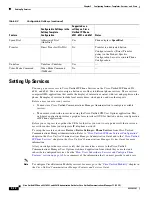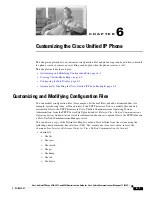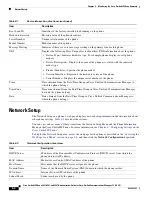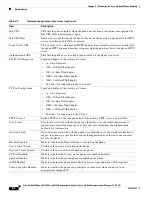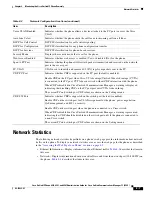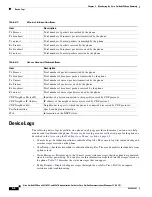
7-3
Cisco Unified IP Phone 6921, 6941, and 6961 Administration Guide for Cisco Unified Communications Manager 7.1 (SCCP)
OL-19025-01
Chapter 7 Viewing Model Information, Status, and Statistics on the Cisco Unified IP Phone
Status Menu
Table 7-2
Status Messages on the Cisco Unified IP Phone 6900 Series
Message
Description
Possible Explanation and Action
CFG file not found
The name-based and default
configuration file was not found on the
TFTP Server.
The configuration file for a phone is created when the
phone is added to the Cisco Unified Communications
Manager database. If the phone has not been added to
the Cisco Unified Communications Manager
database, the TFTP server generates a
CFG File Not
Found
response.
•
Phone is not registered with Cisco Unified
Communications Manager.
You must manually add the phone to Cisco
Unified Communications Manager if you are not
allowing phones to auto-register. See the
“Adding
Phones with Cisco Unified Communications
Manager Administration” section on page 2-9
for
details.
•
If you are using DHCP, verify that the DHCP
server is pointing to the correct TFTP server.
•
If you are using static IP addresses, check
configuration of the TFTP server. See the
“Network Setup Menu” section on page 4-4
for
details on assigning a TFTP server.
CFG TFTP Size Error
The configuration file is too large for file
system on the phone.
Power cycle the phone.
Checksum Error
Downloaded software file is corrupted.
Obtain a new copy of the phone firmware and place it
in the TFTPPath directory. You should only copy files
into this directory when the TFTP server software is
shut down, otherwise the files may be corrupted.
DHCP timeout
DHCP server did not respond.
•
Network is busy—The errors should resolve
themselves when the network load reduces.
•
No network connectivity between the DHCP
server and the phone—Verify the network
connections.
•
DHCP server is down—Check configuration of
DHCP server.
•
Errors persist—Consider assigning a static IP
address. See the
“Network Setup Menu” section
on page 4-4
for details on assigning a static IP
address.
DNS timeout
DNS server did not respond.
•
Network is busy—The errors should resolve
themselves when the network load reduces.
•
No network connectivity between the DNS server
and the phone—Verify the network connections.
•
DNS server is down—Check configuration of
DNS server.


